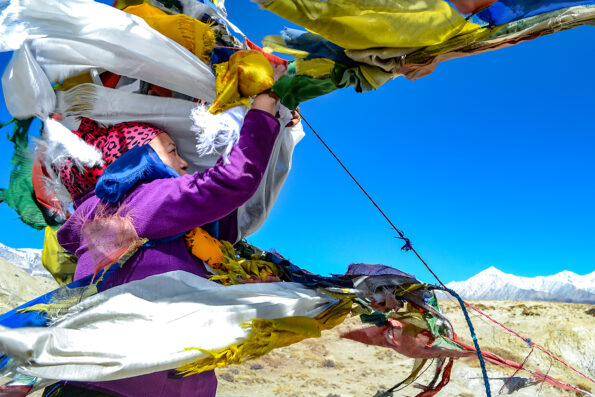
Mar García, GPJ Mexico
In December, Andrea Ramírez, 28, clocked the third-best time ever for a Mexican woman marathoner.
TOLUCA, MEXICO — Andrea Ramírez had dreamed of Olympic gold for years. Then the coronavirus pandemic arrived, and the dream came apart.
“We didn’t know what we were going to do,” says Ramírez, 28, one of Mexico’s premier runners. “It was a stressful, uncertain time.”
A few weeks ago, on a warm, sunny morning, Ramírez returned to the government-funded athletic facility where she once honed her Olympic hopes. It was her first time back in six months.
Though an orange cloth covered her nose and mouth, her brown eyes were happy: Her dream had come back to life.
Ramírez’s plan to qualify for the Olympic Games in Tokyo was eclipsed when, in March 2020, the World Health Organization announced that the coronavirus outbreak had become a pandemic.
The pandemic not only pushed the Tokyo Olympics back by a year. It also forced Mexico’s National Commission for Physical Culture and Sports (known by its acronym in Spanish, CONADE) to close its athletic facilities, including four in Mexico City, one of which provided more than 200 high-performance athletes with space to train, meals, medical service and housing – all for free.
The move upended training regimens, separated teammates, and shattered the support and routines that had long sustained Mexico’s top athletes as they pursued the most important competition of their lives.
“The closure of the facilities had a negative impact,” says Oscar Juanz, deputy director of sport quality for CONADE. “Many of the athletes had to train at home, in parks, gardens. Emotionally, they were affected by the pace of work and the hunger they have to compete, to have their normal rhythm of life.”



Germán Siles Dotor, deputy director of high performance for the General Directorate of Physical Culture and Sports of the state of Mexico, acknowledges that the facilities’ closures torpedoed the athletes’ plans and preparation.
But he says the travails compelled athletes to prove their mettle in new and deeper ways: “The best will be the ones who were most able to adapt to these types of circumstances, and those who have been the most resilient during this time.”
The five members of the national rhythmic gymnastics team had lived and trained together for the past four years in Mexico City. The team won two gold medals in the 2019 Pan American Games, a quadrennial event held among 41 countries. They hoped to build on that performance in Tokyo.
But after the CONADE facilities shut down, they scattered to their homes across the country.
At first, they turned to Zoom training. The athletes connected on the videoconferencing service from their homes to grind through about six hours of workouts led by their trainer. It didn’t work very well.
“The team I have is a set: The five of them compete together,” says the team’s coach, Blajaith Aguilar. “Them being separated does no good.”
Team member Adriana Hernández tried to train in the garage at her house with the balls, ropes, hoops, clubs and ribbons that rhythmic gymnasts use for performances. It was both frustrating and hilarious.
“My equipment would roll out to the street; I’d have to go running after it,” she says. “I felt like I lost confidence a bit with the separation.”
After four months on Zoom, team members rented a house with their own money so they could train together again. That was hard too.
The first day back together, “It was like, ‘Oh, what’s going on?’” says team member Sara Ruiz Velasco. “Sometimes coming back together to training after being off for a weekend is difficult. Imagine coming back together after being away for four months.”
They showed off their music, costumes and routines this weekend at the Pan American Championships, where they came in second place and did not qualify for the Tokyo Olympics, now rescheduled for July 23 through August 8.
By contrast, Ramírez was on her own.
She had come a long way since her university days, when she began running for fun. The track coach asked her to join the team three times, and each time she said no. Finally, he signed her up for a statewide 10,000-meter (6.2-mile) race, where she came in second. She never turned back.
In March 2020, the tall, wiry runner found herself with only nine months to train for an Olympic qualifying event in Arizona, a state in the southwestern United States. Because of coronavirus restrictions, she couldn’t see her coach in person and couldn’t train at the government-funded facility.



Yet she worked out seven days a week, more than four hours a day. Her routine included 90-minute YouTube training videos, which guided her through strength training. She did the exercises with bottles filled with water and sand.
In Toluca, the city in Mexico state where she lives, the marathoner ran 10 to 15 kilometers (6 to 9 miles) daily in the mountains surrounding her home.
Her effort paid off in December 2020, when she took part in The Marathon Project, a competition for professional marathoners, in Arizona. To qualify for Tokyo, she needed to finish in at least 2 hours, 29 minutes and 30 seconds. She ran it nearly three minutes faster.
Her time – 2:26:34 – was a personal best. It was also the third best time ever for a Mexican woman marathoner.
“I felt very accomplished, very at peace with myself,” Ramírez says. “It’s as if I’ve found the place I belong, that I’ve always been looking for. It’s a dream come true now.”
Mar García is a Global Press Journal reporter based in Mexico City. She specializes in reporting stories that transform rote narratives about Mexican art and society.
Translation Note
Sarah DeVries, GPJ, translated this article from Spanish.







